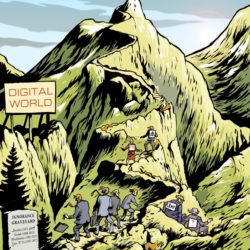Digital age calls for a different supply chain mindset

We are in the midst of a transition from the industrial age to the digital age. The existing mindset and planning processes are therefore no longer adequate, according to Lora Cecere and Sean Culey in a recent SCM webinar on the future of work in the supply chain. Culey: “We have more technology than ever, but we don’t know what to do with it.”
By Marcel te Lindert
Sean Culey, author of the book Transition Point, recalled a conversation about supply chain transformation with someone at Amazon, whose biggest challenge was linked to the intelligent and highly qualified professionals who had moved to Amazon from more traditional companies. “The problem was that he couldn’t ‘deprogram’ those employees,” said Culey. “They were programmed for short-term thinking and risk avoidance. They played not to lose, whereas Amazon wanted them to play to win. Because Amazon was unable to change them, they became a problem for the teams they led. In most cases, there was no other solution but to part ways.”
Mindset shift
This example illustrates the urgent need for a mindset shift in supply chain and Lora Cecere, a respected industry analyst from Supply Chain Insights, agrees. During the webinar, she expressed her frustration at the traditional images of supply chains showing the suppliers on the left and the customers on the right. “If I ask students to draw a supply chain, they always start with a factory, supplier or truck. We’re still very focused on the supply, yet in reality it’s all about the demand. Every supply chain starts with the customers’ customers. They should be on the left, not the right.”
She was also critical of companies that still regard supply chain as a traditional discipline within the organization: “In my view, the supply chain is a combination of flows from our customers’ customers to our suppliers’ suppliers. Those flows span all disciplines. So supply chain is not only about purchasing, production and distribution, but also about driving sales and managing product ranges and new product introductions.”
Football analogy
Rather than the traditional organizational set-up, one alternative is to liken the company to a football team. Sales & Marketing are the strikers, and Supply Chain plays in midfield. And while each member of the team has their own role, players are free to move around – just like on the football pitch – as long as they contribute to the shared aim of scoring as many goals as possible.
“This analogy works as long as everyone does indeed have the same aim in mind,” commented Culey. “But in most companies that’s not the case. In fact, people often have different objectives, depending on their position in the organization. In practice, what we tend to see is more like children’s football, with everyone chasing after the ball at the same time.”
Cecere elaborated: “Most businesses struggle to translate their strategy into effective policy and a good division of roles. They have nothing connecting those three elements together. As a result, there is often more chaos on the pitch than we care to admit.”
Digital age
So the question is, what is the right organizational design? To answer that question, we first need to look to the future. How will companies change in the next ten years? And what does that mean for the culture, mindset and supply chain competencies?
Culey mentioned the current transition from the industrial age to the digital age, which is accompanied by extensive technological disruptions and social upheaval. Traditional companies are disappearing, and new ones with innovative business models are emerging. “Until now we could rely on next year’s business looking about the same as last year’s. But right now, we don’t even know what the next month will bring us. We’re entering a completely new world for which our current planning methods, mindset and leadership ideas are inadequate.”
Cecere echoed the importance of innovation: “But our research shows that only 2 to 3% of companies can be labelled innovators. Most people in the other companies are incapable of out-of-the-box thinking. Everything they do has to meet return on investment (ROI) expectations.”
Value creation
In the digital transformation that many companies are now going through, much of the focus is on new technologies. But according to Culey, the technologies are less important than their mindset, culture and strategy. “You can fill your company with specialists in data science, artificial intelligence and machine learning. But if you don’t know what those specialists should be doing and if those specialists don’t know what value they should be creating, you will be left with an organization that is rich in initiatives and poor in results. Data is worthless if it can’t be used to support the strategy or contribute to the creation of customer value.”
In terms of mindset, there should be a shift from the company to the customer and a focus on solving the customer’s problems rather than simply selling products. This requires a supply chain that revolves around creating customer value rather than cutting costs. “Initially we thought that companies and products were competing with each other, then later that supply chains were, but now we know that it’s actually business models that are competing. Which customer segments do we serve? And what is the value proposition for those customers? The supply chain has to be designed accordingly. Needless to say, new technologies can play a role in that.”
The right questions
In addition to a different mindset, companies need different competencies, such as empathy, adaptability, creativity, problem-solving skills, curiosity and collaboration. “If we train people to compete with machines, we train them to lose. We have more technology than ever, but we don’t know what to do with it. That requires other skills – and not skills that machines can reproduce, like analysing data or processing transactions, but skills that allow us to ask the right questions.”
Culey concluded by noting that businesses are executing many projects, but often without a clear idea: “How are all the tools they implement going to support decision-making and create more customer value? If a project doesn’t contribute to value creation and profitability, it’s merely a distraction from the real goal.”










